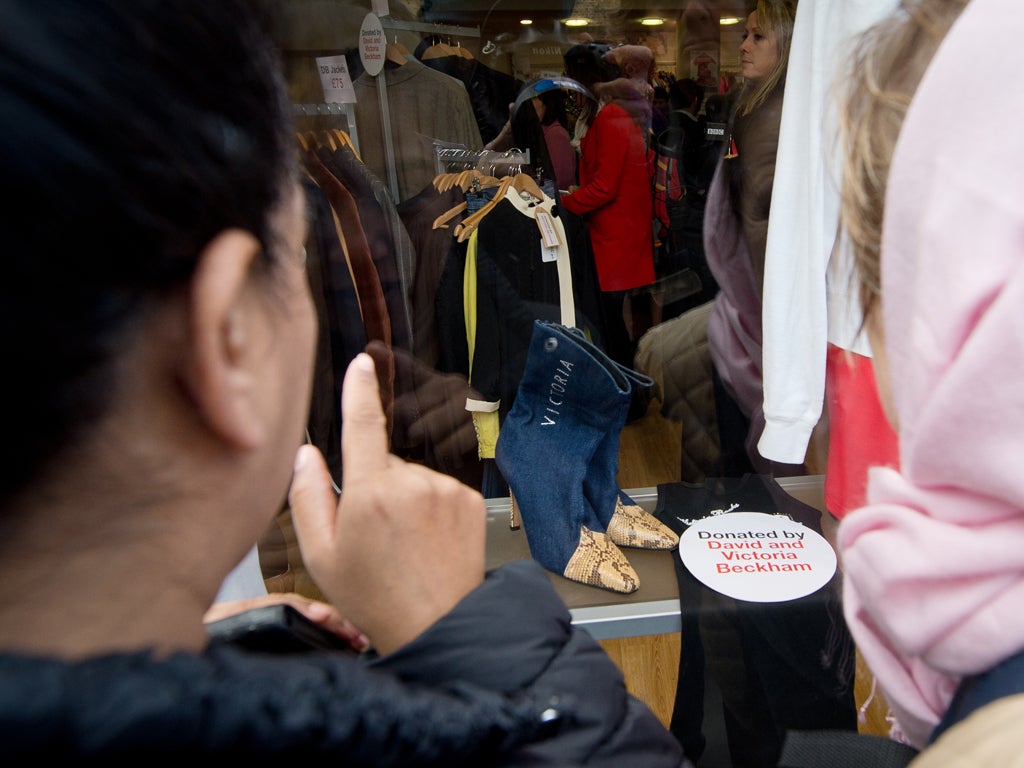We all like a bargain from a charity shop but their main job is to raise funds for good causes
Do charity shops exist to provide vintage-loving hipsters with cheap Armani?

As the annual season of conspicuous consumption gathers its strength for one last swig of fizzy booze tomorrow night, the charity shops must be rubbing their hands with anticipatory glee. All those unwanted Christmas presents will soon be heading their way, filling their shelves with wrong-sized clothing, doubled-up copies of comedy DVDs and mysterious knick-knacks that are neither use nor ornament.
But not all charity shops are created equal, and some have been taking a pounding for overpricing their stock, placing it beyond the reach of their core clientele. London branches have taken particular flak for having the occasional item priced in triple figures.
Surely the problem here is that charity shops serve two masters: their main job is to raise money for their cause. But their secondary purpose is to provide cheap clothes for bargain-hunters. These two ambitions are at odds and charity shop managers presumably have to make a choice.
Some shoppers have complained that clothes are selling for higher prices second-hand than they did when they were new. But, on Saturday, I went into a pop-up shop in Birmingham that was selling jumpers for £5. How can a charity hope to undercut that? Next door to the temporary shop, a hair salon was offering eyebrow tints for a tenner. If we’re prepared to spend twice as much on a different shade of eyebrow than we are on a piece of high street clothing, then charity shops will struggle to compete.
On top of that, there’s the difference between fashion and clothes. Do charity shops exist to provide vintage-loving hipsters with an Armani bargain or to sell clothing to people who need it? Fashion is ephemeral, while clothing is a longer-term investment. You get rid of fashion when fashions change, whereas you keep clothes until they wear out.
So do charity shops merely stock what they’re given or do they specialise? If you run the British Red Cross shop in Chelsea (to which the Beckhams donated piles of clothes earlier this year), positioning your store as a place for fashionistas to find expensive treats will surely raise more money for the Red Cross than piling high and selling cheap.
I’m not sure how much donors think about the charities to which they donate their goods. I give about 200 books a year to the local British Heart Foundation outlet; I get sent a lot of books for work and I don’t have much space to keep them. I do think the BHF is a good cause but I give my books to them because they’re the nearest charity to my flat and books are heavy. If there was an Oxfam bookshop near by, I would probably switch.
But even if other donors are like me, the people who work for charity shops do care about the cause they’re supporting. And if they want to raise as much as possible for their cause, I don’t begrudge them doing so.
How did the experts miss this Old Master?
Though everyone else I know seems to watch it with a religiosity appropriate to Sunday evenings, I have never been a fan of Antiques Roadshow. Perhaps my enjoyment is tempered by the knowledge that I have nothing priceless in the attic, because that’s where my upstairs neighbours live. They might have a Ming vase, I suppose, but I doubt they’d be sharing the proceeds with the rest of us.
Still, I wish I had tuned in to see the presenter and newsreader Fiona Bruce unmask a £400 portrait as a genuine Van Dyck, which makes it the most valuable painting ever discovered on the programme. The whole story feels like the plot of an Alan Bennett play: Father Jamie MacLeod, who runs a retreat in the Peak District, took his painting on the programme, only to find that he could add three zeroes to the price he’d paid for it. And the discovery was made not by one of the programme’s art experts, but by Bruce (who was midway through making a documentary about Van Dyck at the time).
The odd thing is surely that the painting had gone unidentified for so long: Father MacLeod had bought it in an antiques shop, so presumably it had been seen by plenty of amateur and professional experts and gone unnoticed. He’s now planning to sell it to pay for some new church bells, which is about as Bennettian an ending as any story could have.
The power of positive branding
The coming year is apparently going to be the one when self-help books acquire credibility, something they could surely have achieved a lot sooner without vacuous titles referencing planets, cheese and parachutes. The publisher Vintage has decided many of us still need a bit of help, but from a more literary angle. It plans a series of books by writers ranging from Julian Barnes to Jeanette Winterson, about everything from growing up to the fear of dying. But hasn’t great writing, like great music and art, always been a way of understanding ourselves and our fellow man? The difference must be that, this year, it’s got a brand. The books will carry the Shelf Help label. So let’s hope no one is consulting them for a chronic punning problem.

Join our commenting forum
Join thought-provoking conversations, follow other Independent readers and see their replies